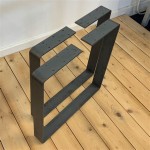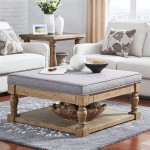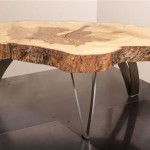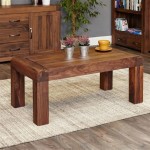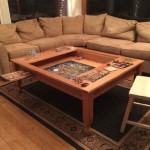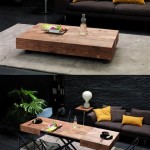How to Paint a Coffee Table with Chalk Paint
Chalk paint has emerged as a popular medium for furniture refinishing due to its ease of use, versatility, and ability to adhere to a variety of surfaces with minimal preparation. When applied to a coffee table, chalk paint can transform a dated or worn piece into a stylish and eye-catching focal point for a living space. The matte finish and ability to be distressed allow for diverse aesthetic outcomes, ranging from rustic farmhouse to elegant vintage. This article provides a comprehensive guide on how to paint a coffee table with chalk paint, covering essential preparation steps, application techniques, and finishing touches to achieve a professional-looking result.
1. Preparing the Coffee Table for Chalk Paint
Proper preparation is critical for successful chalk paint application and long-lasting results. This stage ensures the paint adheres well to the surface, minimizes imperfections, and ultimately contributes to the overall aesthetic appeal of the finished piece. The steps involved primarily center around cleaning, repairing, and lightly sanding the coffee table.
Cleaning: The initial step involves thoroughly cleaning the coffee table to remove any dirt, dust, grease, or existing finishes that could impede paint adhesion. Begin by wiping down the entire surface with a damp cloth. For stubborn grime or grease, use a mild detergent or degreaser. Ensure that all cleaning residue is removed by rinsing with clean water and allowing the table to dry completely. Avoid using abrasive cleaners that could damage the surface.
Repairing: Carefully inspect the coffee table for any imperfections, such as scratches, dents, or chips. These flaws will be more noticeable after painting if left unaddressed. Fill small scratches and dents with wood filler, applying it evenly and allowing it to dry completely according to the manufacturer's instructions. For larger imperfections, multiple applications of wood filler may be necessary. Once the filler is dry, sand it smooth until it is flush with the surrounding surface using fine-grit sandpaper.
Sanding: While chalk paint is known for its ability to adhere to surfaces without extensive sanding, a light sanding is still recommended to create a slightly textured surface that promotes better paint adhesion. Use a fine-grit sandpaper (220-grit or higher) to lightly sand the entire coffee table. The goal is not to remove the existing finish entirely, but rather to create a "tooth" for the paint to grip onto. Focus on smoothing out any rough spots or areas where the existing finish is glossy. Wipe away the sanding dust with a tack cloth to ensure a clean surface for painting. For surfaces that have a very slick or glossy finish, a deglosser can be used instead of sanding to prepare the surface for painting.
Protecting the Work Area: Before beginning the painting process, it is essential to protect the work area to prevent unwanted paint splatters or stains. Cover the floor with drop cloths or plastic sheeting. If painting indoors, ensure adequate ventilation by opening windows or using a fan. Gather all necessary painting supplies, including chalk paint, paintbrushes, rollers, a paint tray, and any optional decorative items, to have them readily available.
2. Applying Chalk Paint to the Coffee Table
Once the coffee table is properly prepared, the next step is to apply the chalk paint. The application process involves selecting the right tools, applying the paint in thin, even coats, and allowing sufficient drying time between coats. The specific technique may vary depending on the desired aesthetic.
Choosing the Right Tools: The choice of paintbrush or roller can significantly impact the final finish. For a smooth, even finish, a high-quality synthetic paintbrush or a foam roller is recommended. Natural bristle brushes may leave brushstrokes, which can be desirable for certain rustic or textured finishes. Consider using a smaller brush for detail work and hard-to-reach areas. A paint tray is essential for loading the brush or roller with paint and preventing drips. Stir the chalk paint thoroughly before use to ensure consistent color and texture.
Applying the First Coat: Dip the brush or roller into the chalk paint, being careful not to overload it. Apply the paint to the coffee table in thin, even strokes, following the direction of the wood grain whenever possible. Avoid applying too much pressure, as this can lead to drips and uneven coverage. Work in small sections, blending each section into the next to create a seamless finish. Chalk paint typically requires multiple coats for full coverage. The first coat may appear somewhat streaky or uneven, but this is normal. Allow the first coat to dry completely according to the manufacturer's instructions, typically for at least two hours.
Applying Subsequent Coats: After the first coat is completely dry, lightly sand the surface with fine-grit sandpaper to smooth out any imperfections or raised areas. Wipe away the sanding dust with a tack cloth. Apply the second coat of chalk paint using the same technique as the first coat. In most cases, two coats of chalk paint are sufficient for full coverage. However, depending on the color and the desired opacity, a third coat may be necessary. Allow each coat to dry completely before applying the next. With each coat, the color will become more opaque and the finish will become smoother.
Creating a Textured Finish (Optional): If a textured or distressed finish is desired, various techniques can be employed. One common method is to apply the paint in a stippling motion using a sponge or textured roller. Another technique involves using a dry brush to create a streaked effect. For a more rustic look, apply the paint unevenly, leaving some areas with less coverage. Experiment with different techniques to achieve the desired aesthetic. Remember that distressing is best done after the paint is fully dry.
3. Finishing the Chalk Painted Coffee Table
The final step in painting a coffee table with chalk paint is to apply a protective finish. Chalk paint is inherently porous and susceptible to staining and damage, so sealing it is crucial for durability and longevity. Wax and clear coats are the two primary options for sealing chalk paint, each offering distinct advantages and aesthetic results. Furthermore, distressing can be used to achieve different aesthetic.
Sealing with Wax: Wax is a traditional sealant for chalk paint, providing a soft, matte finish and enhancing the color and texture of the paint. Apply wax with a clean cloth or wax brush, working it into the surface in a circular motion. Remove any excess wax with a clean cloth, buffing the surface to a smooth, even sheen. Multiple coats of wax may be applied for added protection. Wax typically needs to be reapplied periodically to maintain its protective qualities. Wax provides a beautiful matte finish and adds depth to the color, but it is not as durable as a clear coat and may require more maintenance.
Sealing with Clear Coat: Clear coat, also known as polyurethane or varnish, provides a more durable and water-resistant finish than wax. Apply clear coat with a brush or roller, using thin, even coats. Allow each coat to dry completely before applying the next. Two to three coats of clear coat are typically recommended for adequate protection. Clear coat is available in various sheens, ranging from matte to glossy, allowing one to customize the appearance of the finished piece. Choose a water-based clear coat for easy cleanup and low odor. Clear coat offers superior durability and protection against stains and water damage, making it a suitable option for high-traffic areas. However, it may alter the color of the chalk paint slightly and can sometimes result in a more glossy finish if not using a matte clear coat.
Distressing the Finish (Optional): Distressing is a technique used to create a worn or aged look on painted furniture. After the chalk paint has dried and sealed, use sandpaper to carefully remove paint from edges, corners, and raised areas. The amount of distressing is a matter of personal preference. For a subtle effect, lightly sand a few areas. For a more dramatic effect, sand more aggressively, exposing the underlying wood or previous layers of paint. Experiment with different distressing techniques to achieve the desired look. Sanding blocks or orbital sanders can be used for larger areas or for a more consistent distressed look. After distressing, wipe away any sanding dust with a tack cloth.
Adding Decorative Details (Optional): Once the coffee table is painted and sealed, additional decorative details can be added to personalize the piece. Consider adding stencils, decoupage, or hand-painted designs. Replace the existing hardware with new knobs or pulls to complement the painted finish. Use decorative trim or molding to add architectural interest. The possibilities are endless, allowing one to create a truly unique and personalized coffee table.
By following these comprehensive steps, one can successfully paint a coffee table with chalk paint, transforming it into a stunning and functional piece of furniture that enhances the aesthetic of any living space. The ease of use, versatility, and customizable nature of chalk paint make it an ideal choice for both beginner and experienced DIY enthusiasts. Careful preparation, precise application, and appropriate finishing techniques are key to achieving a professional-looking result that will be enjoyed for years to come.

Chalkboard Top Coffee Table Makeover Liz Marie Blog

Chalkboard Top Coffee Table Makeover Liz Marie Blog

Elegant Coffee Table Makeover Diy With Chalk Paint

Gray Chalk Paint Coffee And Side Table Maison De Pax

Old Thrift Coffee Table Transformed With Chalk Paint Polyshades Artsy Rule

Farmhouse Coffee Table Makeover Our Southern Home

Gray Chalk Paint Coffee And Side Table Maison De Pax

Chalkboard Top Coffee Table Makeover Liz Marie Blog

Coffee Table Makeover With Chalk Paint

How To Refinish A Coffee Table With Milk And Chalk Paint 1905 Farmhouse
Related Posts

